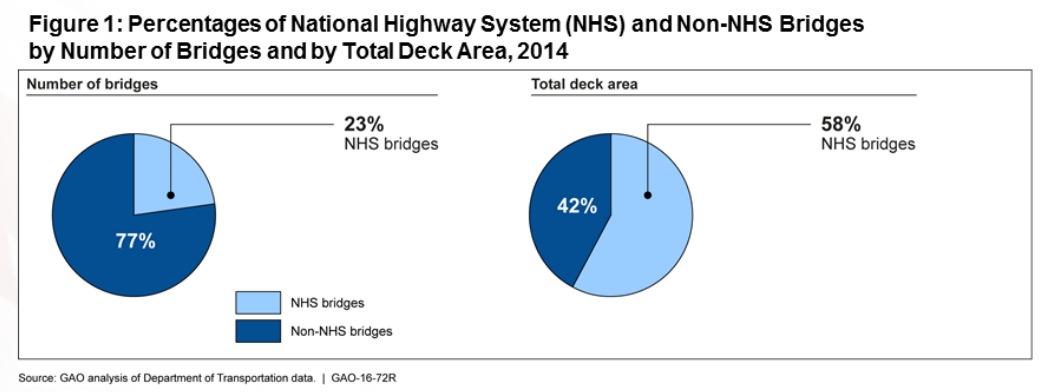UNITED STATES GOVERNMENT ACCOUNTABILITY OFFICE
Bridge safety remains a high-priority issue for our transportation system. Despite recent progress in improving bridge conditions, 10 percent of the nation’s 610,000 bridges were considered structurally deficient as of December 2014, according to the Federal Highway Administration’s (FHWA) National Bridge Inventory (NBI).
FHWA, within the federal Department of Transportation (DOT), provides funding for the design, construction, maintenance, inspection, evaluation, protection, and preservation of the nation’s bridges and oversees the implementation of the National Bridge Inspection Standards, among other duties. State-level DOTs are responsible for ensuring bridge inspections are completed and for inventorying bridges within their states according to federal standards. The Moving Ahead for Progress in the 21st Century Act (MAP-21)1 made some substantial changes in how bridge projects can be managed, funded, and prioritized by states. You asked us to determine what available federal bridge data indicate about the condition of bridges throughout the United States. This report examines the current conditions of the nation’s bridges, as well as changes in bridge conditions that have occurred over the last 10 years. On September 22, 2015, we briefed committee staff on our preliminary findings, and this report transmits a final version of those briefing slides (see enclosure I for briefing slides).
To conduct this work, we reviewed applicable laws, including MAP-21, and relevant FHWA program guidance and documents. We reviewed and analyzed FHWA’s NBI data from calendar years 2005 through 2014—for the nation, each of the 50 states, the District of Columbia (D.C.), and Puerto Rico—by number of bridges and total deck area (which accounts for differences in the size of bridges). Specifically, we limited our analysis to structures classified as highway bridges in the NBI that are at least 20 feet in length, which are those subject to the National Bridge Inspection Standards. We included the following key data elements: deficiency status, whether the bridge was located on or off the National Highway System (NHS), and the bridge’s owner. We assessed the reliability of the data that we used by reviewing documentation and conducting electronic testing and found the data to be reliable for our purposes. We also interviewed FHWA officials on bridge conditions.
We conducted this performance audit from July 2015 to October 2015 in accordance with generally accepted government auditing standards. Those standards require that we plan and perform the audit to obtain sufficient, appropriate evidence to provide a reasonable basis for our findings and conclusions based on our audit objectives. We believe that the evidence obtained provides a reasonable basis for our findings and conclusions based on our audit objectives.
In summary, based on 2014 NBI data, the nation has 610,749 bridges. Of those bridges, 23 percent are on the NHS, and this 23 percent comprise 58 percent of the nation’s total deck area. Nearly 25 percent of all bridges are deficient, with 10 percent categorized as structurally deficient and 14 percent categorized as functionally obsolete. Of bridges on the NHS, 4 percent are categorized as structurally deficient while 17 percent are categorized as functionally obsolete. State agencies own about half of all bridges and over 90 percent of NHS bridges.
We also identified the following trends:
- Between 2005 and 2014, the nation added over 15,000 bridges and almost 400-million square feet of deck area. Between 2005 and 2012, the number of NHS bridges increased by 2,238. Legislative changes in MAP-21 in 2012 expanded the NHS and reclassified some existing bridges.
- The number of deficient bridges decreased from 2005 to 2014. Specifically, our analysis of bridge condition data by number of bridges as well as by deck area indicates that structurally deficient bridges decreased by 21 percent between 2005 and 2014, and functionally obsolete bridges decreased by 6 percent; but at the same time, structurally deficient deck area decreased by 20 percent while functionally obsolete deck area increased by 9 percent.
- The number of deficient NHS bridges decreased from 2005 to 2012. Structurally deficient NHS bridges decreased by 20 percent and functionally obsolete NHS bridges decreased by 2 percent. However, functionally obsolete deck area for NHS bridges increased by 6 percent.
- The number of deficient bridges owned by local and state agencies decreased from 2005 to 2014. Among bridges owned by local agencies, the number of structurally deficient bridges decreased by 20 percent while functionally obsolete bridges decreased by 9 percent. Among bridges owned by state agencies, structurally deficient bridges decreased by 24 percent while functionally obsolete bridges decreased by 3 percent. However, functionally obsolete deck area on state-owned bridges increased by 12 percent.
- Improvement of deficient bridges varied by state. Between 2005 and 2014, the number of structurally deficient bridges decreased in 43 states and D.C. but increased in 7 states and Puerto Rico. The number of functionally obsolete bridges decreased in 33 states and D.C. but increased in 17 states and Puerto Rico.
Download full version (PDF): Information on Bridge Conditions
About the United States Government Accountability Office
www.gao.gov
The U.S. Government Accountability Office (GAO) is an independent, nonpartisan agency that works for Congress. Often called the “congressional watchdog,” GAO investigates how the federal government spends taxpayer dollars.
Tags: U.S. GAO, United States Government Accountability Office








 RSS Feed
RSS Feed